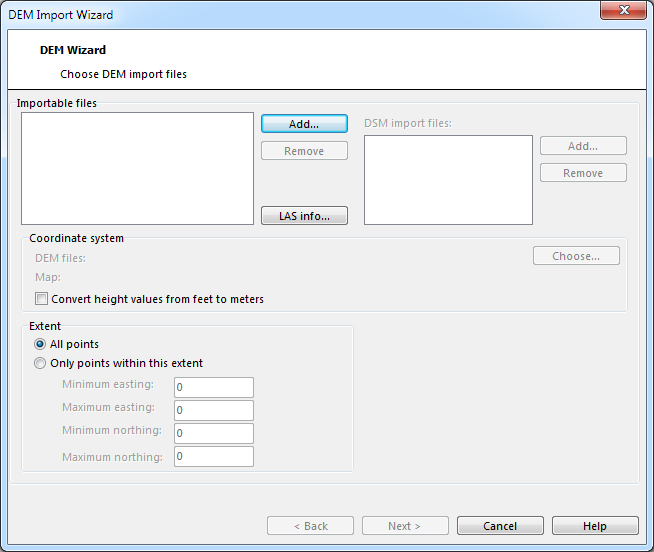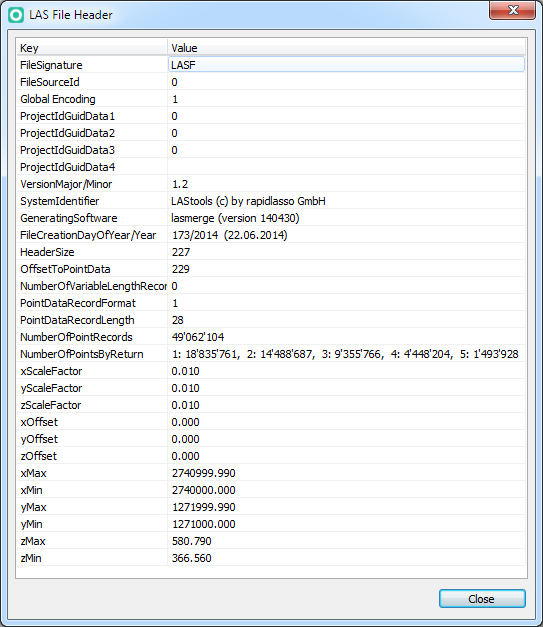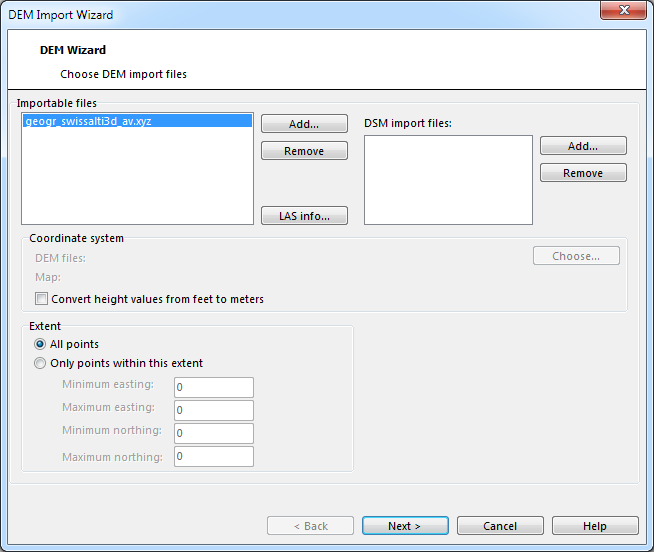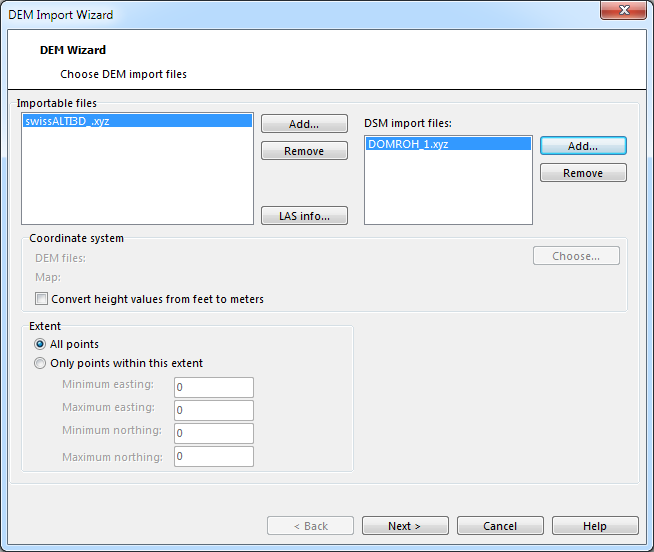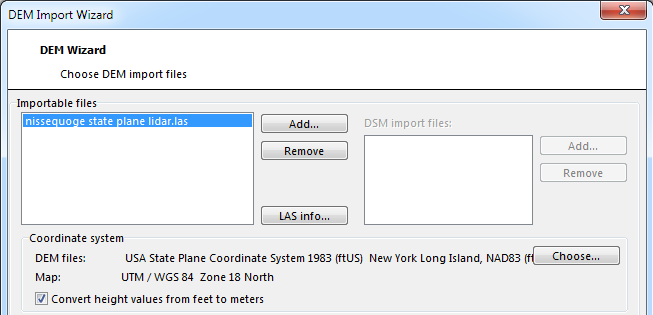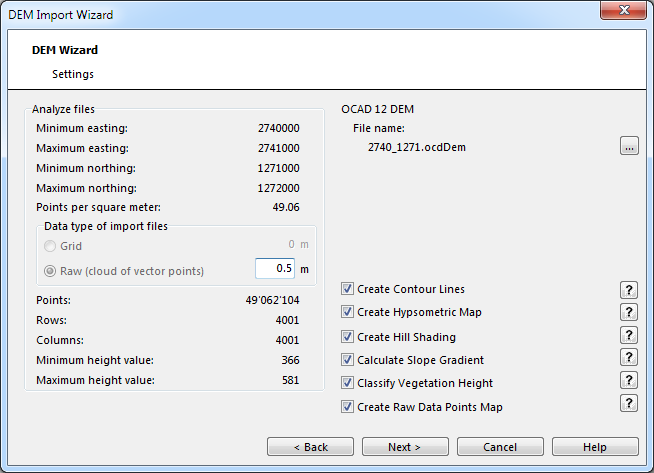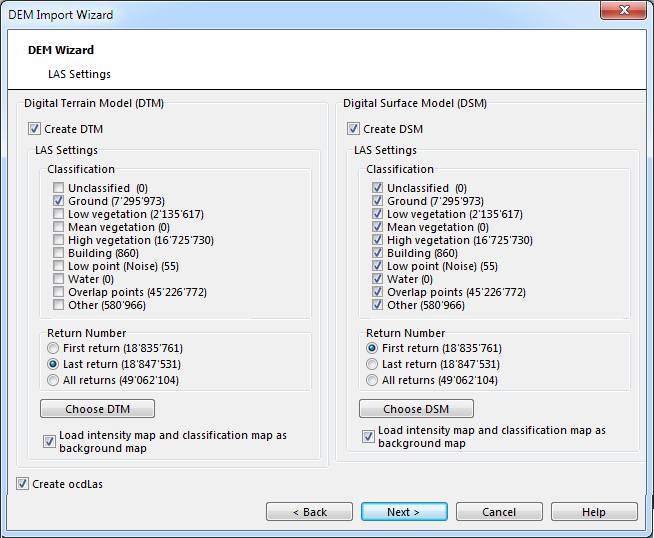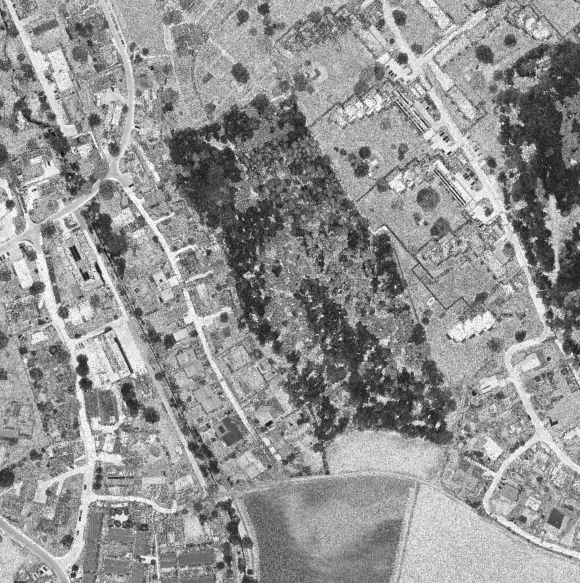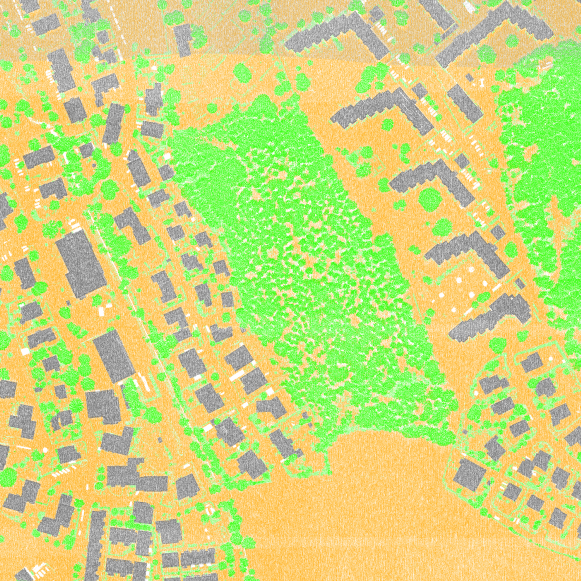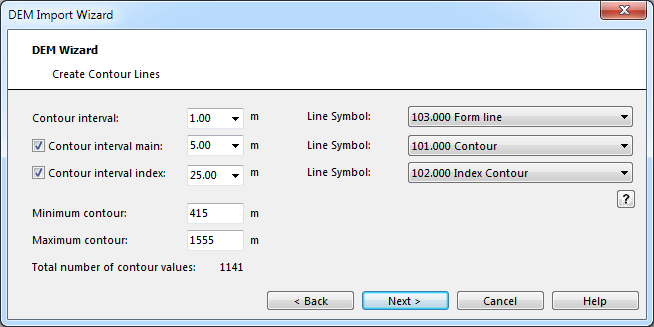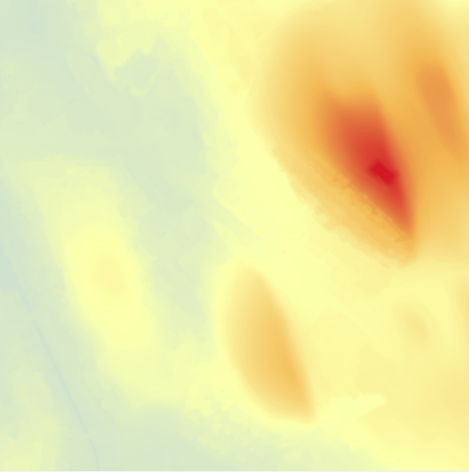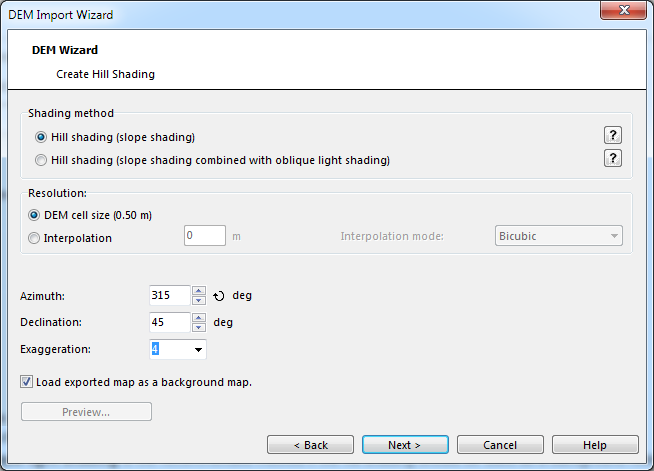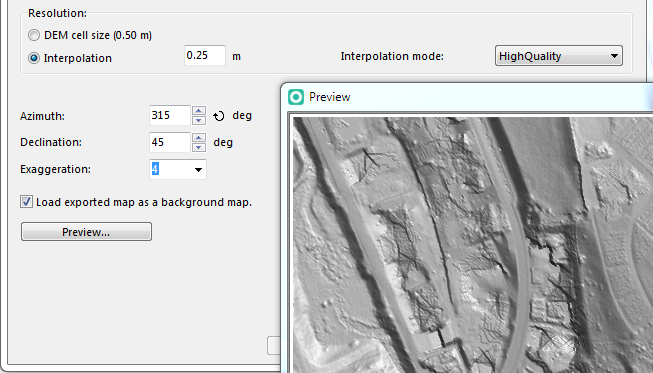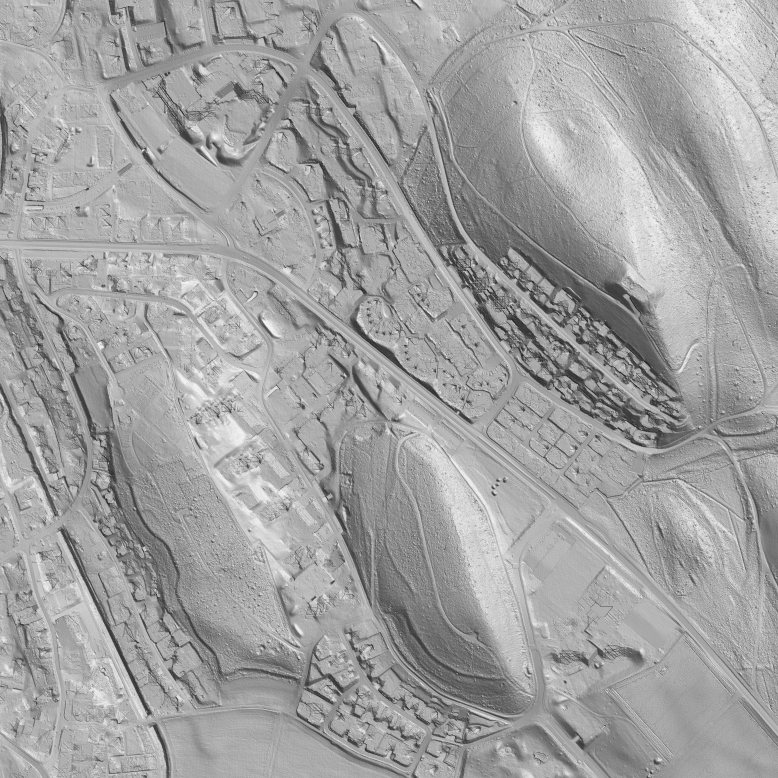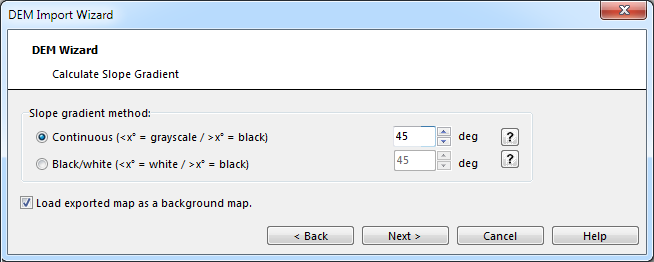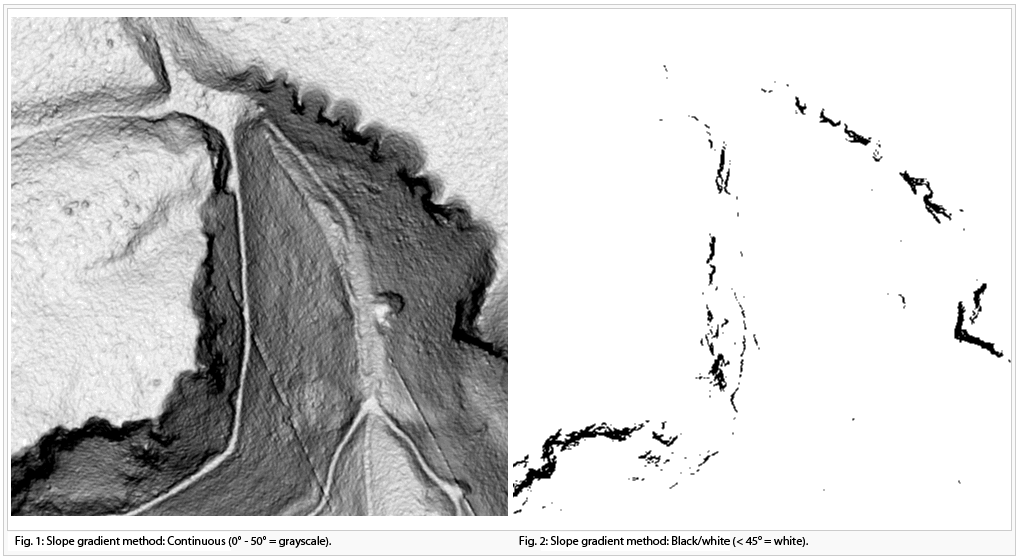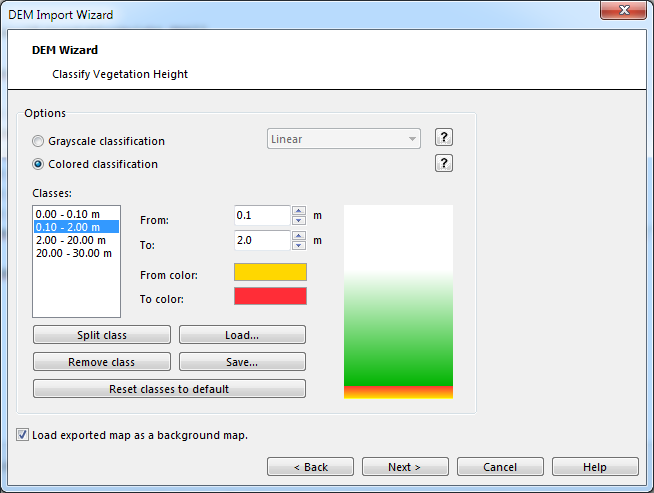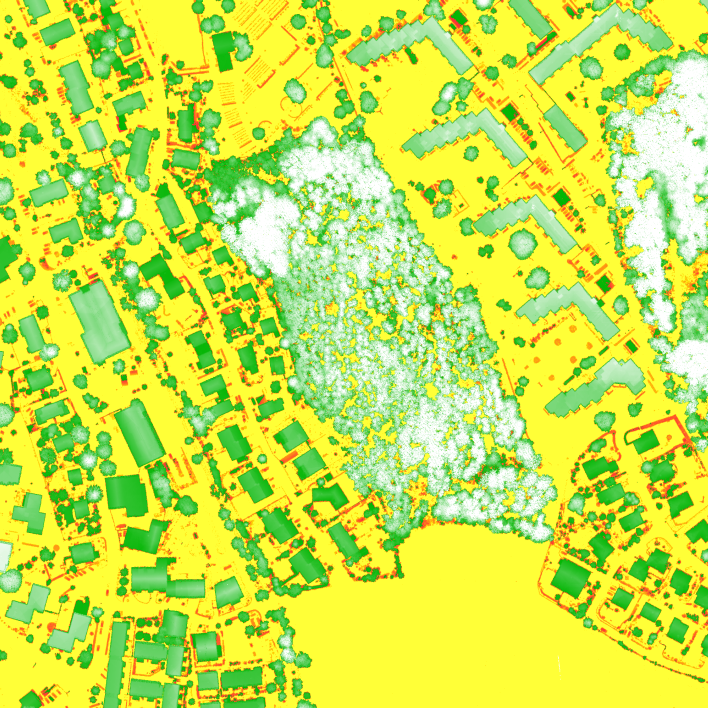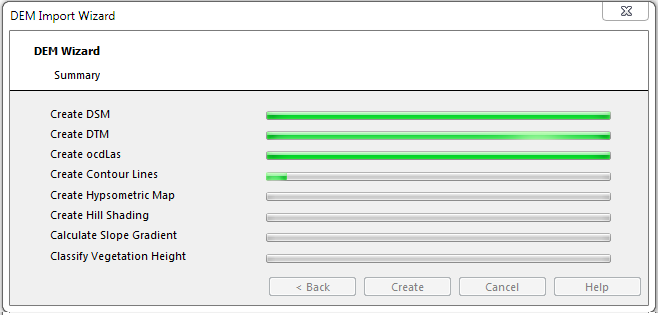DEM Import Wizard: Difference between revisions
No edit summary |
|||
| (32 intermediate revisions by 2 users not shown) | |||
| Line 1: | Line 1: | ||
[[File:Achtung.PNG|25px]] <span style="color:red">You are not on the Wiki page of the newest OCAD Version. Click '''[https://www.ocad.com/wiki/ocad/en/index.php?title=Main_Page here]''' to get there.<br> | |||
The OCAD 12 Wiki will not be updated anymore.</span> | |||
With this DEM Import Wizard you can import DEM data and create the following output formats: | With this DEM Import Wizard you can import DEM data and create the following output formats: | ||
* Contour lines | * Contour lines | ||
| Line 9: | Line 12: | ||
* Classification map | * Classification map | ||
==DEM Import Data [[File:Space.PNG]][[File:Pro40px.PNG|This function is available in OCAD Professional.|link=https://www.ocad.com/en/products/ocad-for-cartography]][[File:Std40px.PNG|This function is available in OCAD Orienteering.|link=https://www.ocad.com/en/products/ocad-for-orienteering]]== | ==DEM Import Data [[File:Space.PNG]][[File:Mas40px.png|This function is available in OCAD Mapping Solution.|link=https://www.ocad.com/en/products/ocad-for-cartography]][[File:Pro40px.PNG|This function is available in OCAD Professional.|link=https://www.ocad.com/en/products/ocad-for-cartography]][[File:Std40px.PNG|This function is available in OCAD Orienteering.|link=https://www.ocad.com/en/products/ocad-for-orienteering]]== | ||
The DEM Import Wizard is able to import files with regular and irregular DEM data. Supported DEM data formats are: | The DEM Import Wizard is able to import files with regular and irregular DEM data. Supported DEM data formats are: | ||
| Line 16: | Line 19: | ||
* ASCII Grid XYZ file (*.xyz) | * ASCII Grid XYZ file (*.xyz) | ||
* LAS file (*.las) | * LAS file (*.las) | ||
* compressed LAS file (*.laz or *.zlas) | * compressed LAS file (*.laz, *.rar or *.zlas) | ||
* SRTM file (*.hgt) | * SRTM file (*.hgt) | ||
=== laz and zLas Files === | === laz and zLas Files === | ||
| Line 28: | Line 31: | ||
Link: https://lta.cr.usgs.gov/SRTM1Arc | Link: https://lta.cr.usgs.gov/SRTM1Arc | ||
=== rar Files === | |||
Please note that OCAD can not handle file names with Non-ASCII character like ''Å''. | |||
==Start Import DEM Wizard== | ==Start Import DEM Wizard== | ||
| Line 66: | Line 72: | ||
[[File:DemImportWizard5.png]] | [[File:DemImportWizard5.png]] | ||
In this example OCAD | In this example OCAD transforms the DEM data from ''US State Plane (Feet)'' to the metric UTM Zone 18 North. | ||
Optional it is possible to convert also the height values from Feet to Meters. | * '''Convert height values from Feet to Meters''': Optional it is possible to convert also the height values from Feet to Meters. Some DEM data in USA are provides in Feet. | ||
* '''Convert height values from mm to Meters''': Optional it is possible to convert also the height values from Millimeters (mm) to Meters. Some DEM data in UK are provides in mm. | |||
* '''Shift elevations below sea level''': OCAD cannot work with elevations below the sea level. OCAD shifts them to 0m when importing the data. This option is a temporary workaround. If the option is checked then OCAD shifts all elevations by 1000m. So check this option if you have terrain below the sea level. | |||
=== Extent === | === Extent === | ||
| Line 131: | Line 139: | ||
[[File:DemImportWizard9.png]] | [[File:DemImportWizard9.png]] | ||
==== Classification Map ==== | ==== Classification Map ==== | ||
Each data point has a classification or is unclassified. This | Each data point has a classification or is unclassified. This classification is shown in a colored map. | ||
Example: | Example: | ||
| Line 150: | Line 158: | ||
* 11 Road (brown) | * 11 Road (brown) | ||
* 12 Overlap pointd (gray) | * 12 Overlap pointd (gray) | ||
=== Create ocdLas === | === Create ocdLas === | ||
Check this option to create an ocdLas file. This is | Check this option to create an ocdLas file. This is a file which contains all poitns of the LiDAR point cloud and it is optimized for the use with OCAD. | ||
This file is used to | This file is used to analyze the vegetation. This file is often very big (> 1 GB). That is the reason why OCAD doesn't load this file by default after creating the dem. | ||
Learn more about the ocdLas | Learn more about the ocdLas file functions on the [[LiDAR_Point_Cloud_Manager]] page. | ||
Click the '''Next''' button. | Click the '''Next''' button. | ||
==Create Contour Lines [[File:Space.PNG]][[File:Pro40px.PNG|This function is available in OCAD Professional.|link=https://www.ocad.com/en/products/ocad-for-cartography]][[File:Std40px.PNG|This function is available in OCAD Orienteering.|link=https://www.ocad.com/en/products/ocad-for-orienteering]]== | ==Create Contour Lines [[File:Space.PNG]][[File:Pro40px.PNG|This function is available in OCAD Professional.|link=https://www.ocad.com/en/products/ocad-for-cartography]][[File:Std40px.PNG|This function is available in OCAD Orienteering.|link=https://www.ocad.com/en/products/ocad-for-orienteering]]== | ||
Choose '''Create Contour Lines''' from DEM menu or from DEM Import Wizard. The '''Create Contour Lines''' dialog box appears. | Choose '''Create Contour Lines''' from '''DEM''' menu or from '''DEM Import Wizard'''. The '''Create Contour Lines''' dialog box appears. | ||
[[File:CreateContourLines.png]] | [[File:CreateContourLines.png]] | ||
This function calculates contour lines based on the | This function calculates contour lines based on the DEM. | ||
*Define 1-3 contour intervals (for example 1m, 5m, 25m) and a pre-selected line symbol (according to the first three line symbols in the settings) for each type appears (can be changed). | *Define 1-3 contour intervals (for example 1m, 5m, 25m) and a pre-selected line symbol (according to the first three line symbols in the settings) for each type appears (can be changed). | ||
: [[File:Hint.jpg]] Contour interval values can be entered manually or chosen from the list. | : [[File:Hint.jpg]] Contour interval values can be entered manually or chosen from the list. | ||
*Specify the minimum (lowest) and maximum (highest) contour for the calculation. | *Specify the minimum (lowest) and maximum (highest) contour for the calculation. | ||
The | == Create Hypsometric Map == | ||
Choose '''Create Hypsometric Map''' from '''DEM''' menu or from '''DEM Import Wizard'''. The '''Create Hypsometric Map''' dialog box appears. | |||
The progression is from highest at left to lowest at right. | |||
[[File:CreateHypsometricMap.PNG]] | |||
This function calculates a grayscale or colored hypsometric map as GeoTIFF file. Choose one of the color ramps. | |||
Optionally you can set white color for areas with no data. | |||
Optionally the created raster file is directly loaded as background map. | |||
[[File:HypsometricMap.PNG]] | |||
== Create Hill Shading == | == Create Hill Shading == | ||
Choose '''Create Hill Shading''' from '''DEM''' menu or from '''DEM Import Wizard'''. The '''Create Hill Shading''' dialog box appears. | |||
This function calculates a shaded relief picture (hill shading). | |||
[[File:CreateHillShading.PNG]] | |||
=== Shading method === | |||
There are two calculation methods available: | |||
* '''Slope shading''' is optimized to see outlines of features like paths in a slope. | |||
* '''Slope shading combined with oblique light shading''' is the recommended method if the hill shading should be used as a background relief of a map.<br>Optionally the calculated hill shading is directly loaded as background map. | |||
=== Resolution === | |||
Aside from the chosen method, there is to define the '''Resolution''' and the '''Interpolation''' mode if chosen. | |||
The default interpolation mode is Bicubic, but there are 7 other algorithm. | |||
Additionaly an '''Azimuth''' and a '''Declination''' of the light source has to be set. Standard settings are 315° (north-west) and 45°. | |||
An '''Exaggeration''' factor of 4 is pre-selected and can be altered. | |||
=== Preview === | |||
The '''Preview...''' button allows you get a first impression of the current setting for your hillshading and can be use to optimize it. | |||
Click and move with the left mouse button allows to pan the current view. | |||
The '''Preview...''' button is only enabeld when importing a dem grid file or an ocddem is already loaded. This function is disabled when importing las/laz files. | |||
[[File:HillShadingPreview.PNG]] | |||
[[File:Hint.jpg|hint]]To detect point and line objects like paths or watercourses from DEM we recommend using the same resolution as the DEM. To create a relief and if the DEM cell size isn’t high then we recommend to set a smaller resolution. | |||
[[File:Hint.jpg|hint]]The default export file format is JPEG and creates an 8 bit JPEG with in grayscale and a world file with the geo reference. If you decide to export the file in TIFF-format, only with resolution option ‘DEM cell size’ then OCAD creates an 8 bit grayscale tiff with color palette. Otherwise a 24 bit RGB tiff. | |||
=== Hillshiding (slope shading) === | |||
[[File:HillShading.PNG]] | |||
=== Hillshiding (slope shading combined with oblique light shading) === | |||
[[File:HillShading2.PNG]] | |||
===Error Message ''Bitmap is too big''=== | |||
The size of the hill shading image is limited. If this error message appears please enter a bigger value for the interpolation. | |||
==Calculate Slope Gradient== | ==Calculate Slope Gradient== | ||
Choose '''Calculate Slope Gradient''' from '''DEM''' menu or from '''DEM Import Wizard'''. The '''Calculate Slope Gradient''' dialog box appears. | |||
[[File:CalculateSlopeGradient.PNG]] | |||
Select one of two different methods: | |||
* Continous (<x° = grayscale / >x° = black) | |||
* Black/White (<x° = white / >x° = black) | |||
The resulting picture can be used to identify cliffs an rock faces. The result can sometimes be significantly improved with a slight adjustment of the gradient (between 42-45 degrees). | |||
Slope gradient also shows paths or relief features independent from a azimut like the [[DEM#Create_Hill_Shading|Hill Shading]]. | |||
[[File:SlopeGradient.PNG]] | |||
== Classify Vegetation Height == | == Classify Vegetation Height == | ||
Choose '''Classify Vegetation Height''' from '''DEM''' menu or from '''DEM Import Wizard'''. The '''Classify Vegetation Height''' dialog box appears. | |||
[[File:DemClassifyVegetationHeight.PNG]] | [[File:DemClassifyVegetationHeight.PNG]] | ||
There are two different options to show vegetation height classification: | There are two different options to show vegetation height classification: | ||
| Line 198: | Line 267: | ||
: - Reset the classes and colors to the default settings by clicking the '''Reset classes to default''' button | : - Reset the classes and colors to the default settings by clicking the '''Reset classes to default''' button | ||
[[File: | [[File:VegetationHeightColor.PNG]] | ||
== Summary== | == Summary== | ||
This dialog is only visible in '''DEM Import Wizard'''. It shows the progress of the different functions. | |||
[[File:DemImportWizardSummary.png]] | [[File:DemImportWizardSummary.png]] | ||
After finishing the process the dialog closes automatically. | |||
Latest revision as of 10:32, 10 December 2018
You are not on the Wiki page of the newest OCAD Version. Click here to get there.
The OCAD 12 Wiki will not be updated anymore.
With this DEM Import Wizard you can import DEM data and create the following output formats:
- Contour lines
- Hypsometric map
- Hill shading map
- Slope gradient map
- Vegetation height map
- Raw data points map
- Intensity map
- Classification map
DEM Import Data 



The DEM Import Wizard is able to import files with regular and irregular DEM data. Supported DEM data formats are:
- ESRI ASCII Grid (*.asc)
- Raw data ASCII XYZ file (*.xyz)
- ASCII Grid XYZ file (*.xyz)
- LAS file (*.las)
- compressed LAS file (*.laz, *.rar or *.zlas)
- SRTM file (*.hgt)
laz and zLas Files
laz and zLas files are compressed LAS file.
OCAD uses the laszip.exe and LASliberator tools form Martin Isenburg to decompress the laz and zLas files.
SRTM Files
This is a world wide available DEM data set from the Shuttle Radar Topography Mission (SRTM). SRTM hgt data import requires that a coordinate system set in the OCAD map file.
Link: https://lta.cr.usgs.gov/SRTM1Arc
rar Files
Please note that OCAD can not handle file names with Non-ASCII character like Å.
Start Import DEM Wizard
Select Import from the DEM menu. The DEM Import Wizard appears. Otherwise you can also drag and drop an DEM file from Windows File Explorer onto the OCAD drawing area.
First use Add button to add at least 1 DEM to the DEM Import Wizard dialog. You have three different options:
- Choose a las files which often contain DTM and DSM data
- Choose only DTM data
- Choose DTM and DSM data
Choose las Files
- After adding a las file you can select the item and click the LAS Info button. The LAS File Header dialog opens wich shows the information from the file header like the Number of Points by Return or the Extent.
Choose DTM Data
Add only the DTM file(s).
Please note that not all functions (e.g. vegetation height) are available if only DTM data are available.
Choose DTM and DSM Data
Add the DTM file(s) on the left side and the DSM file(s) on the right.
If the DSM have an other extent than the DTM then OCAD cuts to the DSM to the extent of the DTM or the choosen extent.
Coordinate System
Usually the DEM data are in the same coordinate system as the OCAD map. So no transformation is necessary.
OCAD supports the transformation during the DEM import. Click the Choose button to select the coordinate system of the DEM data.
In this example OCAD transforms the DEM data from US State Plane (Feet) to the metric UTM Zone 18 North.
- Convert height values from Feet to Meters: Optional it is possible to convert also the height values from Feet to Meters. Some DEM data in USA are provides in Feet.
- Convert height values from mm to Meters: Optional it is possible to convert also the height values from Millimeters (mm) to Meters. Some DEM data in UK are provides in mm.
- Shift elevations below sea level: OCAD cannot work with elevations below the sea level. OCAD shifts them to 0m when importing the data. This option is a temporary workaround. If the option is checked then OCAD shifts all elevations by 1000m. So check this option if you have terrain below the sea level.
Extent
DEM data are often big. So the calculation needs needs a lot of time and memory. If you do not need the whole extent of DEM data you can enter here the used extent.
Please note that when an object is selected in the drawing area and you open the DEM Import Wizard, OCAD used the extent of the selected object as default extent.
Click the Next button. OCAD imports the file(s). Depends on the file size of data this step can takes some minutes. The Settings dialog appears.
Settings
This dialog shows the information about the DEM data.
Analyze Files
OCAD shows here the information about the map extent and the average number of point per square meter.
If the source file is a regular grid (data type of import files = grid), the Cell size box is set to read only. OCAD sets the same cell size for the imported DEM. For irregular DEM data source (data type of import files = raw) the cell size can be set in the 'cell size' box. For these DEM's OCAD interpolates a regular grid with the specified cell size during the import. The cell size depends on the import data and the further usage of the DEM.
![]() The Cell size range is between 0.01 and 650 m.
The Cell size range is between 0.01 and 650 m.
File Name
During the import procedure the imported DEM must be saved in the OCAD DEM file format (*.ocdDem) and it is loaded to the OCAD map.
Choose here the file name of this DEM file.
If only one import file is choosen OCAD uses by default the file name of the import file. Otherwise the filename of the ocd map.
If the ocd file is untiteled OCAD exports the DEM files in the temporary user directory (C:\Users\XXX\AppData\Roaming\OCAD\OCAD 12\Tmp).
Options
OCAD can create different outputs depending on the choosen import data type (DTM and DSM or only DTM).
Check or uncheck these outputs. OCAD shows for each output a page with options later in the DEM Import Wizard.
LAS Settings
The LAS Settings dialog is only visble when importing las/laz/zlas files.
On the left side OCAD shows the information about the DTM, on the right to the DSM. If is possible to create both DEMs in one step or only one DEM.
Each point is classified. The value in the round brackets is the number of points for this classification.
- Click the Choose DTM button to reset the Classification ans Return Number option to the default values.
- Click the Choose DSM button to reset the Classification ans Return Number option to the default values.
Usually the default setting are right. But in some cases it makes sense to uncheck the overlap point for the DSM. It depends on the used data. Change also this settings if the data are not classified.
Create Intensity and Classification Map
Check the option Create intensity and classification map to create these maps. If created OCAD loads these raster maps as background maps.
Intensity Map
Each data point has an intensity of the returned laser beam. This intensity is shown in a grayscale map.
Example:
Classification Map
Each data point has a classification or is unclassified. This classification is shown in a colored map.
Example:
The classification tiff image has the following color index:
- 0 Created, never classified (light gray)
- 1 unclassified (red)
- 2 Ground (yellow)
- 3 Low Vegetation (light green)
- 4 Medium Vegetation (green)
- 5 High Vegetation (dark green)
- 6 Building (Generic) (gray)
- 7 Low point (noise) (gray)
- 9 Water (blue)
- 10 Bridge (brown)
- 11 Road (brown)
- 12 Overlap pointd (gray)
Create ocdLas
Check this option to create an ocdLas file. This is a file which contains all poitns of the LiDAR point cloud and it is optimized for the use with OCAD.
This file is used to analyze the vegetation. This file is often very big (> 1 GB). That is the reason why OCAD doesn't load this file by default after creating the dem.
Learn more about the ocdLas file functions on the LiDAR_Point_Cloud_Manager page.
Click the Next button.
Create Contour Lines 


Choose Create Contour Lines from DEM menu or from DEM Import Wizard. The Create Contour Lines dialog box appears.
This function calculates contour lines based on the DEM.
- Define 1-3 contour intervals (for example 1m, 5m, 25m) and a pre-selected line symbol (according to the first three line symbols in the settings) for each type appears (can be changed).
- Specify the minimum (lowest) and maximum (highest) contour for the calculation.
Create Hypsometric Map
Choose Create Hypsometric Map from DEM menu or from DEM Import Wizard. The Create Hypsometric Map dialog box appears.
The progression is from highest at left to lowest at right.
This function calculates a grayscale or colored hypsometric map as GeoTIFF file. Choose one of the color ramps.
Optionally you can set white color for areas with no data.
Optionally the created raster file is directly loaded as background map.
Create Hill Shading
Choose Create Hill Shading from DEM menu or from DEM Import Wizard. The Create Hill Shading dialog box appears.
This function calculates a shaded relief picture (hill shading).
Shading method
There are two calculation methods available:
- Slope shading is optimized to see outlines of features like paths in a slope.
- Slope shading combined with oblique light shading is the recommended method if the hill shading should be used as a background relief of a map.
Optionally the calculated hill shading is directly loaded as background map.
Resolution
Aside from the chosen method, there is to define the Resolution and the Interpolation mode if chosen. The default interpolation mode is Bicubic, but there are 7 other algorithm.
Additionaly an Azimuth and a Declination of the light source has to be set. Standard settings are 315° (north-west) and 45°.
An Exaggeration factor of 4 is pre-selected and can be altered.
Preview
The Preview... button allows you get a first impression of the current setting for your hillshading and can be use to optimize it. Click and move with the left mouse button allows to pan the current view.
The Preview... button is only enabeld when importing a dem grid file or an ocddem is already loaded. This function is disabled when importing las/laz files.
![]() To detect point and line objects like paths or watercourses from DEM we recommend using the same resolution as the DEM. To create a relief and if the DEM cell size isn’t high then we recommend to set a smaller resolution.
To detect point and line objects like paths or watercourses from DEM we recommend using the same resolution as the DEM. To create a relief and if the DEM cell size isn’t high then we recommend to set a smaller resolution.
![]() The default export file format is JPEG and creates an 8 bit JPEG with in grayscale and a world file with the geo reference. If you decide to export the file in TIFF-format, only with resolution option ‘DEM cell size’ then OCAD creates an 8 bit grayscale tiff with color palette. Otherwise a 24 bit RGB tiff.
The default export file format is JPEG and creates an 8 bit JPEG with in grayscale and a world file with the geo reference. If you decide to export the file in TIFF-format, only with resolution option ‘DEM cell size’ then OCAD creates an 8 bit grayscale tiff with color palette. Otherwise a 24 bit RGB tiff.
Hillshiding (slope shading)
Hillshiding (slope shading combined with oblique light shading)
Error Message Bitmap is too big
The size of the hill shading image is limited. If this error message appears please enter a bigger value for the interpolation.
Calculate Slope Gradient
Choose Calculate Slope Gradient from DEM menu or from DEM Import Wizard. The Calculate Slope Gradient dialog box appears.
Select one of two different methods:
- Continous (<x° = grayscale / >x° = black)
- Black/White (<x° = white / >x° = black)
The resulting picture can be used to identify cliffs an rock faces. The result can sometimes be significantly improved with a slight adjustment of the gradient (between 42-45 degrees).
Slope gradient also shows paths or relief features independent from a azimut like the Hill Shading.
Classify Vegetation Height
Choose Classify Vegetation Height from DEM menu or from DEM Import Wizard. The Classify Vegetation Height dialog box appears.
There are two different options to show vegetation height classification:
- Gray scale classification with options: Linear, Quadratic negative, Quadratic positive
- Colored classification: Define classes with a height and color range
- - Split a class into two classes by clicking the Split class button
- - Remove a class by clicking the Remove class button
- - Load the settings from a text file by clicking the Load button
- - Save the settings to a text file by clicking the Save button
- - Reset the classes and colors to the default settings by clicking the Reset classes to default button
Summary
This dialog is only visible in DEM Import Wizard. It shows the progress of the different functions.
After finishing the process the dialog closes automatically.
